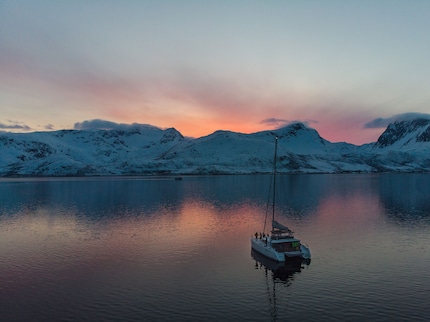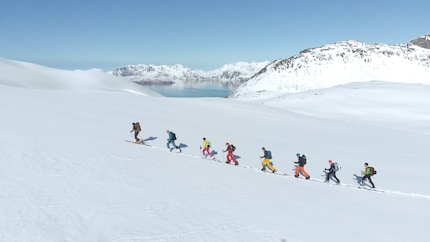
DJI Mavic Air Fly More Bundle Onyx Black
21 min, 430 g, 12 Mpx

Spring in Switzerland: Meadows are flourishing, flowers in every imaginable colour are hanging from trees, insects are hatching from their holes and drones are buzzing over rooftops, forests and meadows - I let the Mavic Air soar in the Norwegian winter.
Touring skiing in latitudes far north of Switzerland. Views from peaks over the most beautiful fjords and descents directly to the sea. Plus sun from early in the morning until late in the evening. When night falls, you can even see the northern lights. That has to be captured.
Alongside Beni, who is travelling somewhere in the world all the time, two former study friends - Leoni and Marius - were also on the ski touring trip to Norway. Both as crazy about technology as me. That's why, in addition to the new Sony A7 III and the old a7 II, lenses in all zoom ranges, GoPro and gimbal, a drone was also a must. As we were going to produce a short highlight clip anyway, it was an obvious choice to immediately test the drone in everyday holiday life
.

DJI Mavic Air Fly More Bundle Onyx Black
21 min, 430 g, 12 Mpx
I can say one thing up front - the Mavic Air impressed me in almost every situation. Not only is it so small and light that I hardly noticed it in its practical packaging in my touring rucksack. On long tours, every gram you carry around with you counts. The remote control also fits into a small corner thanks to the detachable joysticks. You'll be in the air in two to three minutes. Once you have inserted your smartphone into the remote control, folded out the arms of the drone and removed the practically designed gimbal protection, you're ready to go.
Steep ridges, cornices so big they make me shudder, half-grown birch trees up to around 200 metres above sea level and endless landscapes are just some of the motifs we capture with the little Air. Always on the lookout for a special angle and camera movements. Whether we place the drone directly above us and point the camera downwards or let it hover just a few centimetres above our heads and then march through below. We also use the actually impressive tracking function. We walk up a wide slope with skins under our skis and let the drone circle around us, follow us or fly in front of us. In tracking mode, however, the drone makes somewhat jerky movements that cause the image to jerk slightly on closer inspection. The drone does not live up to our rather high expectations 100%.

With the remote control firmly in both hands and the drone on the flat hand of a fellow traveller, the easiest way to start the device is via the smartphone display. We're usually lucky with the weather. But you still need a windbreaker on the summits, because the high-altitude wind is our constant companion. And the drone is still stable in the air. I am amazed. If you fly it in stronger winds, you might get a wind warning. If it's a more massive drone like the Mavic Pro or Phantom, it happens later.
Not only over high cliff edges, but also over the sea, we manage to take unique shots. At first, I hardly dare to fly it over the endlessly deep ocean. Skipper Thomas from the Czech Republic scares me a little when he talks about drone water excursions he has experienced: "Oh, wouldn't be the first drone on the seabed that has set sail with me."
Over time, however, I gain so much confidence in the device that this is no longer a problem. The only time I decide against letting the drone take off is when the catamaran is moving. A few thoughts about the take-off and landing point determined by GPS and the moving ship lead me to leave the drone on safe ground. The risk was too great and I didn't want to confess to my boss that I had sunk the drone.
In most cases, the image quality of DJI drones is not the best out of the box. Too saturated colours, high contrasts and an oversharpened image. Having just arrived in Norway, we check into a lodge. Later, eight of us board the catamaran. While Leoni and Beni go shopping for dinner, Marius and I are bored and play with the drone. After a few tests and comparing profiles, we recommend these settings:
If you stick to these settings and then edit the videos in a colour editing program, you will have good quality videos. If all this is too much effort for you and you only use your clips for Instagram and co. anyway, the standard profile is also quite ok. However, the differences in quality compared to the Mavic Pro or the even more expensive Phantom 4 Pro with a larger sensor are clearly visible.

DJI claims a flight time of 21 minutes. These appear to be laboratory values. The longest flight in Norway was around 15 minutes. After that I had to land. The large difference is certainly also due to the cool temperatures in the north. Batteries lose capacity when it's cold. However, a quarter of an hour is usually enough for us and with a total of three batteries in the Fly-More bundle, you get 45 minutes.
On the remote control you will find a switch labelled "Sport". If you flip this switch, the Mavic Air takes off like a rocket. It's no longer possible to take beautiful shots, but you're almost controlling a racing drone with the remote control. I reached 69.1 km/h in favourable conditions. Flying fun is guaranteed and I can also escape birds that don't enjoy the drone.
Yes, if I'm complaining at a high level, there are some shortcomings.
Data can be transferred from the 8GB internal memory or the SD card directly from the drone to the PC via a USB-C connection. However, the remote control is charged via a micro USB port. Huh? Why not just spend a few more dollars on the new standard and use USB-C, the one-for-all connection everywhere? Now DJI has simply included a dongle that is easy to lose. #donglelife.
The manufacturer specifies a maximum range of 4 kilometres. In Norway, we managed 2.6 kilometres. That's just about enough in an open field. As soon as there is a hill or other obstacle in the way, the connection is lost. It's not uncommon for the drone to then fly home. In Switzerland, with more obstacles, disconnections are likely to increase. If you do not abort the process, it will land at the take-off position determined by GPS. With the Mavic Pro, you have a more loyal companion.

Have you always flirted with buying a drone and didn't know which one? I can recommend the Mavic Air to anyone who wants an advanced flying device with good image quality. And the excuse of not having it with you doesn't apply. The little Air from DJI is too handy.
However, if you'd rather spend a little more time on colour processing and have significantly better video quality, it's worth taking a look at the DJI Phantom 4 Pro or waiting for a Mavic Pro II. Rumours promise a lot. However, I maintain that the vast majority of hobby pilots will be happy with the Air. Form factor, flight characteristics and a good camera for the size are a great package.


As a Multimedia Producer, preparing multimedia content and knowing about cutting-edge technology is my business. My main focus at digitec is producing videos. I can’t wait to try out new products such as cameras, drones or smartphones as soon as they’re launched. This is where being at the source comes in rather handy. When I’m not working, I’m probably skiing, biking or hiking – the mountains are my place to be.